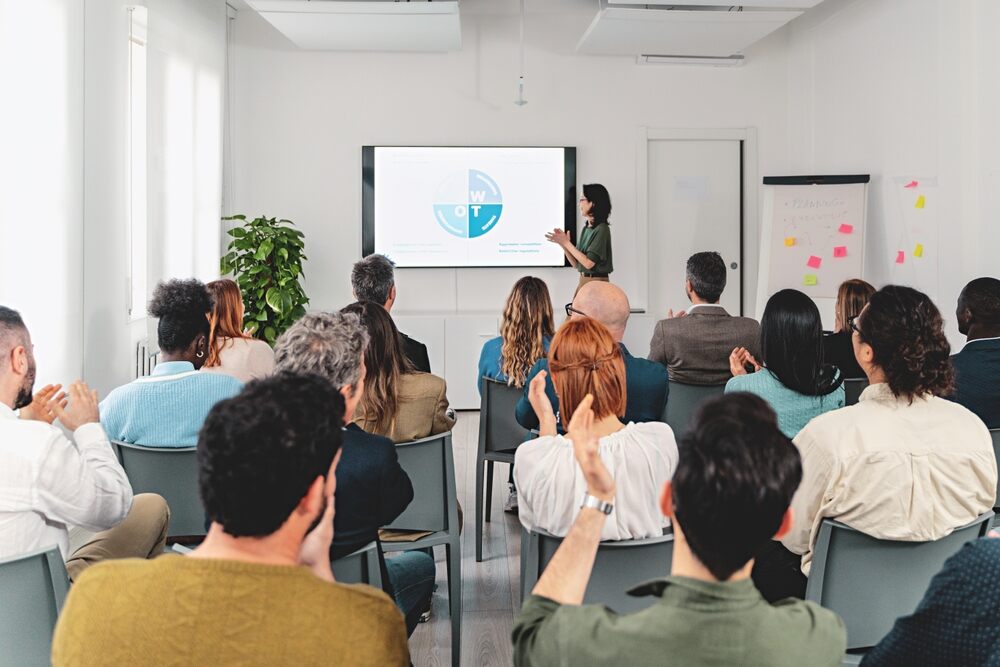4 Proven Methods on How to Improve Employee Performance

June 11, 2024
What is one major challenge that many organizations are facing now?
If your answer is talent scarcity, you hit the nail on the head. With job roles and skills changing at a fast rate, a shortage of skilled workers is giving many HR leaders sleepless nights. On top of that, the future remains uncertain. We are unaware of what skill needs will arise in the coming years.
One effective way to deal with this problem is through employee development. Installing the concept of employee growth and development into your company’s work culture has multiple benefits that businesses can’t afford to ignore.
If you are wondering what employee development is, keep reading.
What is Employee Development?
An employee development plan involves skill development and knowledge growth. The objective is to improve competency, allowing employees to play a larger role in the organization.
It can be done through training modules, seminars, workshops, higher education courses, mentorship, and more. The process helps foster a learning culture in the organization and adapt the business to fast-changing skill needs and job roles.
Learning new methods and technologies allows employees to improve their performance and support their business goals more effectively. It helps them to progress towards their career goals and navigate a fast-changing job environment. Overall, it is a great way to overlap their career development plans with the future needs of the business.
Note that the terms “employee training” and “employee development” may sound similar, but they are not. While the former is a short-term concept, the latter involves long-term planning.
Training is used to meet the immediate goals of the business and is part of the development plan. On the other hand, employee development involves enhancing leadership skills and empowering employees to meet future business challenges.
Why is Employee Development Important?
Contrary to what some may believe, an employee development plan is not a corporate buzzword. One research conducted in 2022 indicates that employees consider employee development training as one of the best ways of improving company culture.
Learning and skill enhancement opportunities allow employees to fulfill career advancement goals. They can either move vertically up the corporate ladder, or horizontally across the company functions.
Likewise, knowledge gained helps stave off employee stagnation and improves motivation. Plus, a development plan for employees has a positive impact on their job trajectory. Letting them know that there is a place for them in the company’s plans, positively impacts their feelings about the company,
Managing employee turnover is exceptionally expensive and needs significant time investment. Moreover, replacing critical individuals is a hard task. Another report points out that an organization with a strong learning culture helps boost employee retention rates. Obviously, retaining top talent will help you cut costs and stay competitive.
Besides, a robust employee development training plan will help you attract the top job candidates. Highlighting the career development opportunities in the organization sends a strong positive signal to potential candidates. It builds your image as an organization that cares and allows employees to grow with it.
Another big plus of an organization with a learning culture is talent agility. When the employees stay up to date in their fields, they remain well-prepared to handle the challenges that may come their way. Then again, the additional confidence that they gain provides extra job security.
What is the Most Effective Way to Improve Employee Development?
When it comes to employee development, there is no one-size-fits-all approach. Companies need to develop plans and personalized training sessions based on their unique needs. At the same time, you need to remove any management barriers and rigid structures that hinder growth.
However, no matter the type of employee development plan you execute, the managers need to play a key role. We believe that managers are in the best position to spot the signs of employee stagnation and waning optimism.
They can collect feedback from the employees about their growth plans and balance it with the business requirements to quantify the training needs. In other words, managers better understand employee priorities than the L&D team.
Conduct in-depth discussions with managers from various levels to understand the bottlenecks in employee growth. This also helps create the space and time for training sessions within a busy employee schedule. Beyond that, managers can help employees apply their learnings by integrating the new skills into the employee’s daily tasks.
In addition, feedback from the managers is essential for the management to understand the real impact of employee development training. Conversely, they can provide constructive feedback to employees that can promote further growth.
How to Build an Employee Development Plan?

Structuring the right development plan for the employees is not a simple task. Here are four steps that will help you to create the framework of an employee development plan.
Perform a skills gap analysis
The first step is to set clear goals for the program. For that, compare the current skills of your workforce with the skills they will need to meet the long- and short-term business goals. You may need to boost the efficiency of your sales force or need additional leaders to manage a growth spurt. Understanding the skill gaps will help streamline the training and ensure maximum benefits.
Talk to the employees
Every employee strives for personal and professional growth. That makes it necessary to discuss the development plan with them to understand their career goals. Aligning the company goals with the individual needs is the best way to move forward.
In case employees are struggling with any aspect of their tasks, additional training or mentoring in the specific area will be needed.
Create an action plan
Once the needs are identified, determine the type of training methods that will deliver the best results. This can be webinars, special training sessions, or working with a subject matter expert. Encouraging passion projects or rotational programs that let employees work in different departments can be effective too.
The other aspect of the action plan is to set clear expectations and objectives for managers and employees. Make sure that all employee development goals should be time-bound and measurable.
Track performance results
Tracking employee performance is essential to determine if your employee development ideas are working. Meet with employees and managers to find out how things are moving and collect their feedback. That way, you will be able to identify any shortcomings and make the process more effective.
Final Thoughts
Skill building through employee development is not just a perk anymore. It is a necessity for driving organizational success and developing a human-centered company culture.
By motivating your employees to grow you are investing in your most important asset- employee talent. Nothing drives growth better than having loyal and productive employees in your workforce.
Now, how about a tool that can help your employees reach their best potential while ensuring well-being in the workplace?
Implementing Strive to improve employee performance! It’s that simple.
